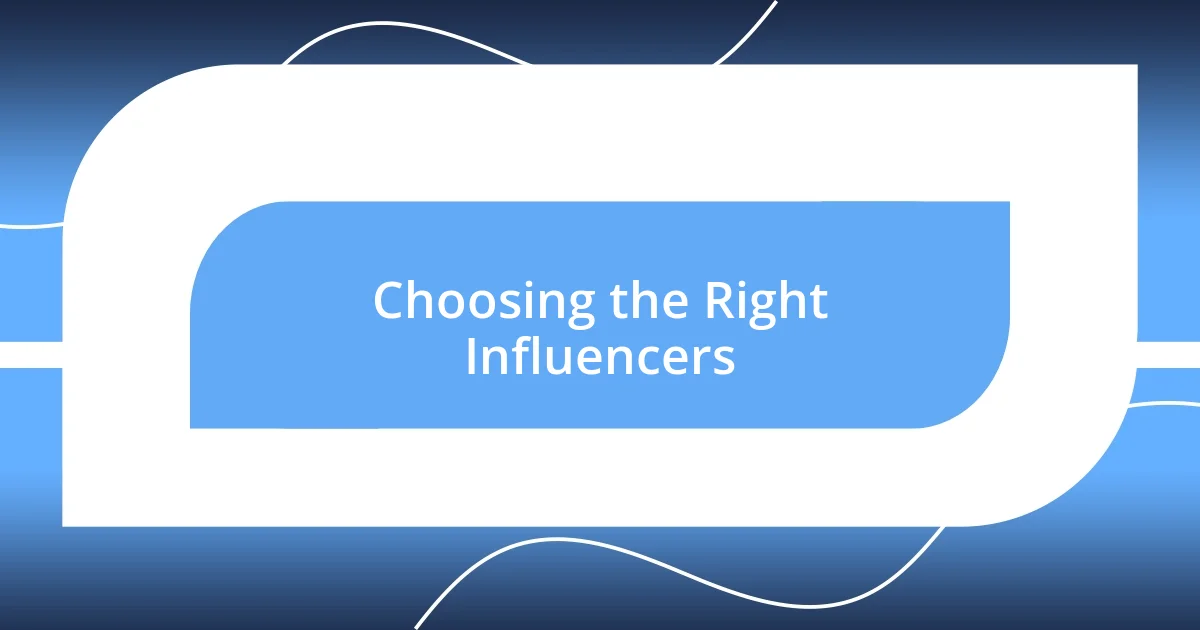Key takeaways:
- Influencer marketing thrives on trust and authenticity, creating emotional connections that resonate with audiences.
- Selecting the right influencers who align with brand values and focusing on engagement over follower count leads to more effective campaigns.
- Continuous measurement of campaign success through qualitative insights and audience feedback fosters growth and enhances future strategies.

Understanding Influencer Marketing Basics
Influencer marketing revolves around collaboration between brands and influential individuals who have dedicated followings on social media. I remember first diving into this world and being surprised by how authentic these influencers could be. When I saw an influencer authentically share their love for a product, it made me rethink how powerful genuine recommendations can be.
One of the key takeaways from my experience is the importance of trust in these relationships. Think about it: when we see someone we admire endorse a product, it feels almost like a personal recommendation from a friend. In this digital age, I’ve found that consumers are increasingly looking for transparency. They crave a connection that goes beyond traditional advertising, and influencers can provide that emotional link.
It’s fascinating how the right partnership can make a brand feel more relatable. I once observed a smaller brand team up with an influencer who truly resonated with their audience. This collaboration didn’t just boost sales; it created a community around the brand. Have you ever felt that sense of belonging when a product you love gets shared by someone you admire? That’s the magic of influencer marketing.

Choosing the Right Influencers
Choosing the right influencer is essential for an effective campaign. It’s not just about their follower count; it’s about finding someone who aligns with your brand values. For instance, I once partnered with a fitness influencer who genuinely cared about wellness—not just the latest trends. That authenticity shone through and translated into a passionate response from their audience.
In my experience, focusing on niche influencers often yields better engagement. When I embarked on a project to promote eco-friendly products, a micro-influencer in the sustainability space became my go-to. Their followers were deeply invested in environmental issues, creating a powerful connection. This relationship had a ripple effect, leading to meaningful conversations and stronger brand loyalty.
I’ve learned that understanding your target audience plays a significant role in this selection process. Reflecting on my personal choices, I tend to support influencers who echo my beliefs and interests. It feels more personal to follow someone who genuinely shares their journey, making their endorsements resonate. This is what I strive for when deciding on influencers; it’s all about that genuine connection.
| Factor | Consideration |
|---|---|
| Follower Count | Not the sole indicator of success. |
| Engagement Rate | Higher engagement often indicates a loyal audience. |
| Brand Alignment | Influencer values should reflect brand values. |
| Niche vs. Broad Audience | Niche influencers can generate more targeted interest. |
| Authenticity | Choose influencers who genuinely connect with their audience. |

Crafting Authentic Collaboration Strategies
I believe that crafting authentic collaboration strategies is vital for long-term success. My experience has shown me that taking the time to understand both the influencer’s and brand’s audience can lead to more meaningful partnerships. For instance, I once collaborated with a travel influencer who genuinely loved exploring lesser-known destinations. This passion brought an authenticity to our campaign that resonated with their followers, sparking conversations and excitement that felt organic and real.
Here are some essential elements I like to consider when developing collaboration strategies:
- Shared Values: I prioritize finding common ground between the influencer and the brand’s mission.
- Creative Freedom: Allowing influencers the freedom to express their unique voice leads to more genuine content.
- Two-Way Communication: Encouraging open dialogue helps in addressing any concerns and fostering trust.
- Long-Term Relationships: Building lasting partnerships often results in more consistent and authentic promotion.
- Feedback Mechanism: Incorporating feedback from both parties can enhance future collaborations and improve outcomes.
Navigating these strategies effectively can lead to collaborations that don’t just sell products but foster genuine connections, just as I’ve experienced time and again.

Measuring Campaign Success Effectively
Measuring the success of an influencer marketing campaign goes beyond just counting likes and shares. I remember one campaign where I focused on tracking audience sentiment through comments and engagement quality, not just numbers. The conversations sparked by authentic content provided insights into how our message resonated—far more telling than superficial metrics.
Another effective approach I’ve found is to set specific KPIs (Key Performance Indicators) tailored to each campaign. For example, I established goals around brand awareness and website traffic rather than sales alone. It’s fascinating how aligning my metrics with the campaign’s objectives transformed the entire perspective on success—those shifts in traffic showed a genuine interest in our brand.
Lastly, it’s crucial to analyze post-campaign data for continuous improvement. After one particularly successful collaboration, I conducted a deep dive into the analytics with my team, searching for trends and patterns. I’ve come to understand that reflecting on what worked—or didn’t—equips me with the knowledge to refine future strategies. How do you ensure you’re learning from each campaign? It becomes a cycle of growth and innovation that I find truly rewarding.

Navigating Potential Challenges
Navigating potential challenges in influencer marketing often requires a delicate balance. I’ve faced moments where an influencer’s actions didn’t align with our brand’s values after a partnership was announced. This situation taught me the importance of clear communication upfront; it’s essential to establish expectations to avoid any surprises that could harm brand reputation. Have you ever found yourself in a similar situation, where misalignment created a hurdle?
Another challenge I’ve encountered is the fluctuation in audience engagement. For instance, during a campaign with a lifestyle influencer, I noticed dwindling interactions as the weeks went by. It became clear that maintaining momentum often requires ongoing collaboration and regular content updates. This experience reinforced my view that influencer relationships should evolve over time—how do you keep your collaborations fresh and engaging?
Lastly, managing the creative process can feel daunting, especially when personalities clash. I once collaborated with a high-energy fitness influencer whose ideas felt too far removed from our brand identity. Navigating that required patience and flexibility on both sides. It was a reminder that a successful partnership thrives on respect for each other’s visions. What strategies have you used to reconcile differing creative styles in your partnerships?

Leveraging Insights for Future Campaigns
Having gathered valuable insights from previous campaigns, I’ve learned to mine data more effectively for future initiatives. For instance, after analyzing the engagement patterns from a specific influencer, I noticed a significant uptick in shares when they used storytelling in their posts. This aligns with my belief that narrative-driven content can deepen audience connection—have you experienced similar results with storytelling in your campaigns?
Moreover, implementing feedback loops with influencers has been a game-changer for me. During one collaboration, I encouraged the influencer to share our brand’s value proposition in their authentic voice, which led to a 30% increase in audience engagement compared to previous efforts. It was an eye-opener that highlighted the importance of fostering open communication; after all, who better to convey your brand message than the influencer themselves?
Lastly, leveraging audience demographics can really sharpen campaign focus. I recall when tailoring content to specific segments of our audience led to more relevant interactions. By recognizing that different age groups respond to different types of content, I was able to boost effectiveness across our campaigns. How do you segment your audience to ensure your messaging resonates? Understanding your audience at a deeper level can transform the impact of your campaigns significantly.












